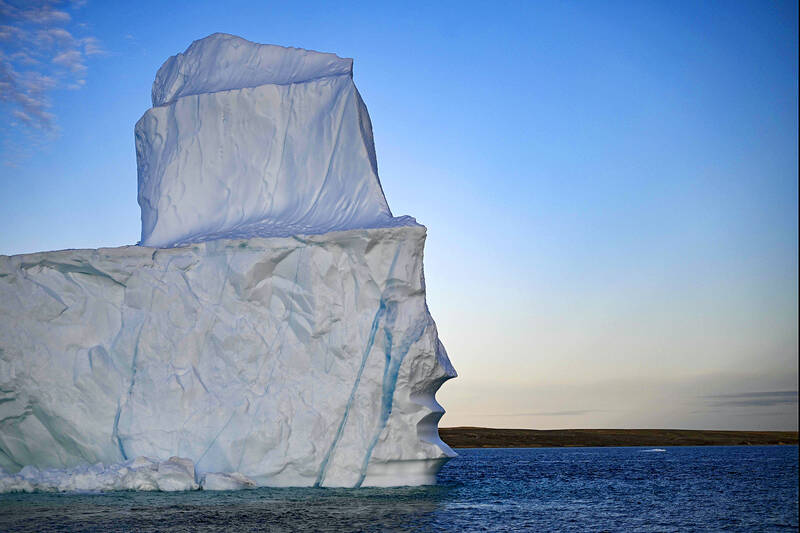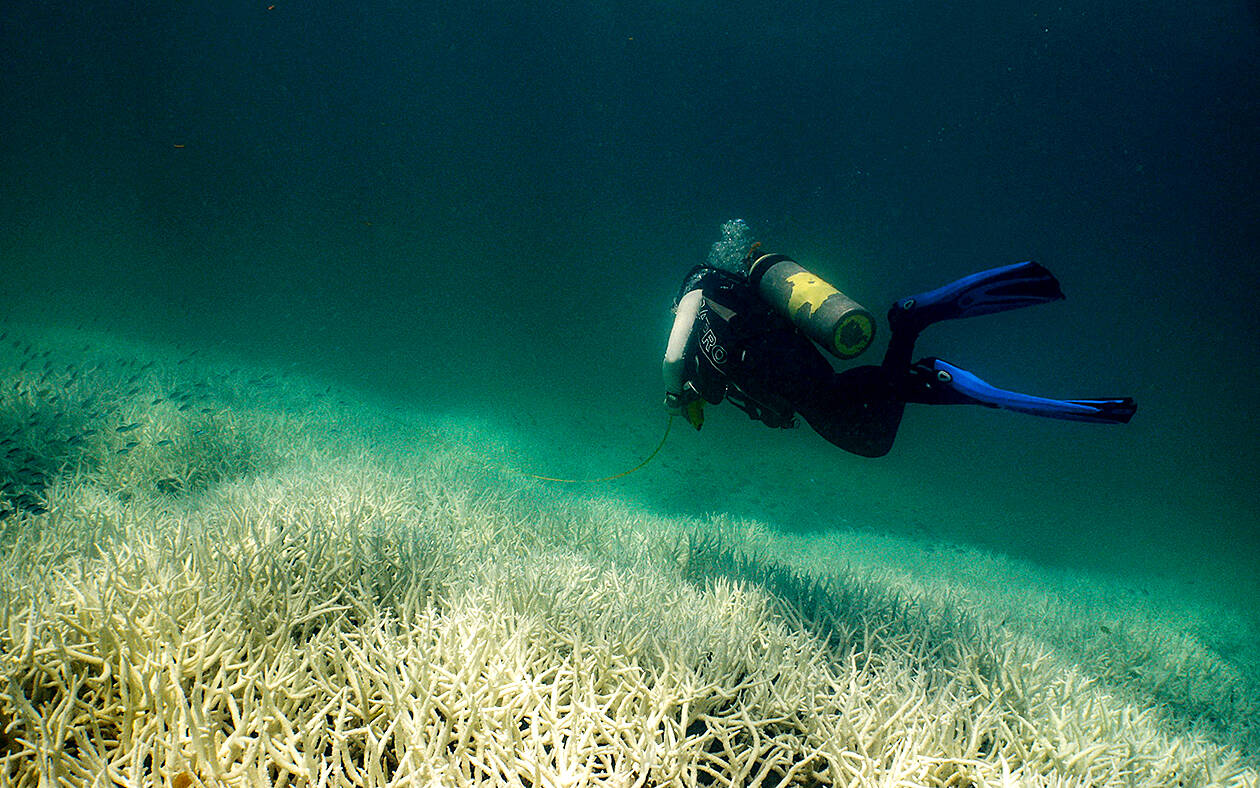A few weeks ago I found myself at a Family Mart talking with the morning shift worker there, who has become my coffee guy. Both of us were in a funk over the “unseasonable” warm weather, a state of mind known as “solastalgia” — distress produced by environmental change. In fact, the weather was not that out of the ordinary in boiling Central Taiwan, and likely cooler than the temperatures we will experience in the near-future.
According to the Taiwan Adaptation Platform, between 1957 and 2006, summer lengthened by 27.8 days, while winter shrunk by 29.7 days. Winter is not only warmer, it is also much shorter. Both the number of days with heavy rain, and days with no rain have increased too. Overall, Taiwan gets less rain than it used to. Sea level rise around the island is over 3.5mm annually and accelerating.
HOT WATER

Photo: AFP
Although the world’s nations have pledged to hold warming to 1.5°C over pre-industrial levels, last year’s heating shattered all records. It is a terrifying augury of the future. As a paper out in the journal of the American Meteorological Society just this month observed, the extreme sea surface temperatures in the North Atlantic “lie at the fringe of the expected mean climate change for a global surface-air temperature warming level (GWL) of 1.5°C, and closer to the average at a 3.0°C GWL.” Last year’s warming was beyond all previous experience: in July and again in September “the observations were four standard deviations larger than the 1982–2011 average.”
Other recent papers on mean sea temperatures show that ocean temperature levels are the highest ever recorded by science. Some September within the next decade or two we can expect the first ice-free arctic in human history.
One reason that the numbers don’t penetrate is because the UN Intergovernmental Panel on Climate Change (IPCC), founded in 1988, and the UN’s Framework Convention on Climate Change (UNFCC), which began meeting annually in 1995, are dominated by fossil fuel producers who have forbidden the reports to carry mention of paleo-climates, precisely to prevent readers from making the connection to previous mass extinctions. The last meeting of the UNFCC Conference of Parties (COP28) was held in Dubai in November and December last year. Dubai’s wealth is based entirely on fossil fuels.

Photo: Reuters
If we went back in time to find an epoch comparable to the one we are now entering, we would have to return to the Pliocene three or more million years ago, when carbon dioxide levels hit 400 parts per million and the ocean was 20 meters higher. We are now at CO2 levels of over 425 ppm and rising. A 2015 paper on the Permian-Triassic extinction, the worst in planetary history, observed that humans are actually in reach of that catastrophe: “We find that the temperature anomaly during the end-Permian extinction is consistent with [approximately] 1.5 doublings of atmospheric pCO2, and that the implied climate sensitivity is 5–6°C, within the upper range of values produced by climate models.”
At this point I should somehow segue to “What does this mean for Taiwan?” It isn’t necessary to explain that an export-dependent island with a shriveling population, slowly flooding ports and major cities, slammed by ever more powerful typhoons, and surrounded by oceans that are too hot and gradually losing their ability to produce oxygen, is in trouble. Oxygen depletion has been predicted to occur around 2100 when ocean temperatures rise around 6°C, but last year’s ocean temperature spike is one datum among many showing that our climate models are too conservative: climate change is outracing them.
Here, too, I am supposed to list all the signals from Taiwan: how temperatures on Yushan (玉山) are roughly 2°C higher than they were a century ago, or changes in the behavior of cherry blossoms, or events like fish die-offs and algae blooms. But that is just stamp collecting.
What is Taiwan doing about this?
Electricity prices are going up, an inevitable product of rising fossil fuel costs and rising corporate debt at Taiwan Power Company (Taipower), with decisions on the new prices coming out next month. The price rises will occur even among the lowest levels of use, which had been frozen to protect the poor. Government officials said that some households in the lower rate category have installed more than one electrical meter in their homes; subdividing overall household use so each fell into the smaller user category.
There was nothing in it about raising rates to encourage conservation, though that will likely occur in response to high electricity prices, and fund switching to renewables. When the current administration first came to power in 2016 it forwarded an ambitious plan to break up Taipower, but that turned out to be largely vaporware. Instead, Taipower maintains a near monopoly on power production from renewable energy.
GREEN OR GREED?
It is absolutely urgent that this monopoly ends. In January Greenpeace Taiwan released another call for the elimination of Taipower’s control over renewables and the establishment of a new framework that supports the generation of renewable energy by local enterprises. Surprisingly, green electricity is in high demand in Taiwan and many businesses cannot satisfy their desire for it. A Greenpeace spokesman observed that just 5 percent of the renewable energy generated in Taiwan was available for purchase through T-Rec energy marketing system. Most of the remainder went to Taiwan Semiconductor (TSMC).
Also in January, speaking at the Commonwealth Economic Forum, Deputy Minister of Economic Affairs Tseng Wen-sheng (曾文生), who is the chairman of Taipower, was quoted in local media as saying that adjustments of the country’s electricity prices “always take fairness, price controls, inflation, and [the country’s] competitiveness into consideration.” Look carefully at that list: see anything about conservation or renewables?
South Korea looms large in the economic imaginings of Taiwan’s policymakers, and true to that siren call of competitiveness, Minister Tseng noted that Taipower looks to Korea’s Korea Electric Power Co (KEPCO), which also runs massive debts, as a model. Like Taipower, KEPCO is allergic to renewables, with just 3 percent of power coming from renewables in 2021.
Ironically, as analysts have noted in both cases, had they transitioned to renewables earlier and installed much larger renewable energy capacity, they would not now be facing ballooning debts due to volatility in the fossil fuel markets, and passing on the debt to consumers in the form of price hikes.
Notes from Central Taiwan is a column written by long-term resident Michael Turton, who provides incisive commentary informed by three decades of living in and writing about his adoptive country. The views expressed here are his own.

Most heroes are remembered for the battles they fought. Taiwan’s Black Bat Squadron is remembered for flying into Chinese airspace 838 times between 1953 and 1967, and for the 148 men whose sacrifice bought the intelligence that kept Taiwan secure. Two-thirds of the squadron died carrying out missions most people wouldn’t learn about for another 40 years. The squadron lost 15 aircraft and 148 crew members over those 14 years, making it the deadliest unit in Taiwan’s military history by casualty rate. They flew at night, often at low altitudes, straight into some of the most heavily defended airspace in Asia.

Many people in Taiwan first learned about universal basic income (UBI) — the idea that the government should provide regular, no-strings-attached payments to each citizen — in 2019. While seeking the Democratic nomination for the 2020 US presidential election, Andrew Yang, a politician of Taiwanese descent, said that, if elected, he’d institute a UBI of US$1,000 per month to “get the economic boot off of people’s throats, allowing them to lift their heads up, breathe, and get excited for the future.” His campaign petered out, but the concept of UBI hasn’t gone away. Throughout the industrialized world, there are fears that

Like much in the world today, theater has experienced major disruptions over the six years since COVID-19. The pandemic, the war in Ukraine and social media have created a new normal of geopolitical and information uncertainty, and the performing arts are not immune to these effects. “Ten years ago people wanted to come to the theater to engage with important issues, but now the Internet allows them to engage with those issues powerfully and immediately,” said Faith Tan, programming director of the Esplanade in Singapore, speaking last week in Japan. “One reaction to unpredictability has been a renewed emphasis on

Taiwan’s democracy is at risk. Be very alarmed. This is not a drill. The current constitutional crisis progressed slowly, then suddenly. Political tensions, partisan hostility and emotions are all running high right when cool heads and calm negotiation are most needed. Oxford defines brinkmanship as: “The art or practice of pursuing a dangerous policy to the limits of safety before stopping, especially in politics.” It says the term comes from a quote from a 1956 Cold War interview with then-American Secretary of State John Foster Dulles, when he said: ‘The ability to get to the verge without getting into the war is